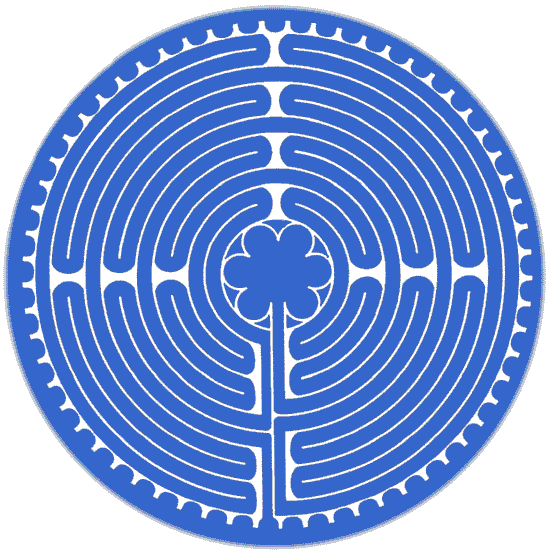
The History of the Labyrinth
People, formal cultures, and traditions have used the spiral and labyrinth designs as a symbol of their search for meaning and guidance. The labyrinth is a "unicursal" or one path design - there are no tricks or decisions to be made - much as the surrender to walking a sacred spiritual path in life - our only decision is to choose spirit/God and surrender to divine guidance. The labyrinth is non -denominational . People of all faiths and people longing to re-connect to faith come to walk labyrinths. "I found peace and a sense of God's presence that I had not experienced since childhood," responds a labyrinth walker.
Some of the earliest forms of labyrinths are found in Greece, dating back to 2500-2000 B.C.E. This labyrinth is called the Cretan labyrinth or classical seven-circuit labyrinth. So much a part of the fabric of this early society was the labyrinth, that it was embossed on coins and pottery. Early Christian labyrinths date back to 4th century, a basilica in Algeria. The Chartres design labyrinth is a replica of the labyrinth laid into the cathedral floor at Chartres, France in the thirteenth century. The Chartres design is a classical eleven-circuit labyrinth (eleven concentric circles) with the twelfth being in the center of the labyrinth.
One walks a labyrinth by stepping into the entrance and putting one foot in front of the other. After traveling through all the paths and windings, the walker comes into the center - the six - petal rosette, after a time there, the walker returns out to cover the same path out as in. Total travel is approximately one third mile, depending on the size of the labyrinth. The Chartress Cathedral Labyrinth is 42' in diameter. My portable labyrinth is 35' wide.
Guidelines & Suggestions to Walking
There is no "right" or "wrong" way to walk a labyrinth. I ask and aid walkers at my workshops by stating "quiet the mind, open the heart". Because you are walking, the mind is quieted. Labyrinth walks are sometimes referred to as "body prayer" or walking meditation. I suggest that people may want to see the walk as three parts to a whole experience - but I recognize many go through the walk and these parts at different stages. The entrance can be a place to stop, reflect, make prayer or intention for the spiritual walk you are about to take. The walk around the design to the center can be a "letting go" - a quieting of the thoughts, worries, lists of tasks to do, a letting go unto the experience of being present in the body. Arrival at the center rosette - a place of prayer/meditation - "letting in" Gods guidance, the divine into our lives.
When ready, the walk out "letting out" takes us back into our lives, empowered by spirit to transform our lives and actions. In many ways, I see the labyrinth as a call to action, a transformation spiritual tool for people. It can aid healing, help in releasing grief, (people often shed tears during the "letting go"), help guide through troubled times, aid in decision making, illuminate our purpose in life, and act as a tool of celebration and thanks. I have seen it be many things for many people. It is important to recognize it as a spiritual practice, not a magical tool. Its work is our commitment to enter into the sacred spiritual walk, not merely once, but to use it as part of an ongoing spiritual practice.
The vision of the world-wide Labyrinth Project is to establish labyrinths in cathedrals, retreat centers, hospitals, prisons, parks, airports, and community centers so they are available to walk in times of joy, in times of sorrow and when we are seeking hope.
The material above was accessed at http://www.sacredwalk.com/